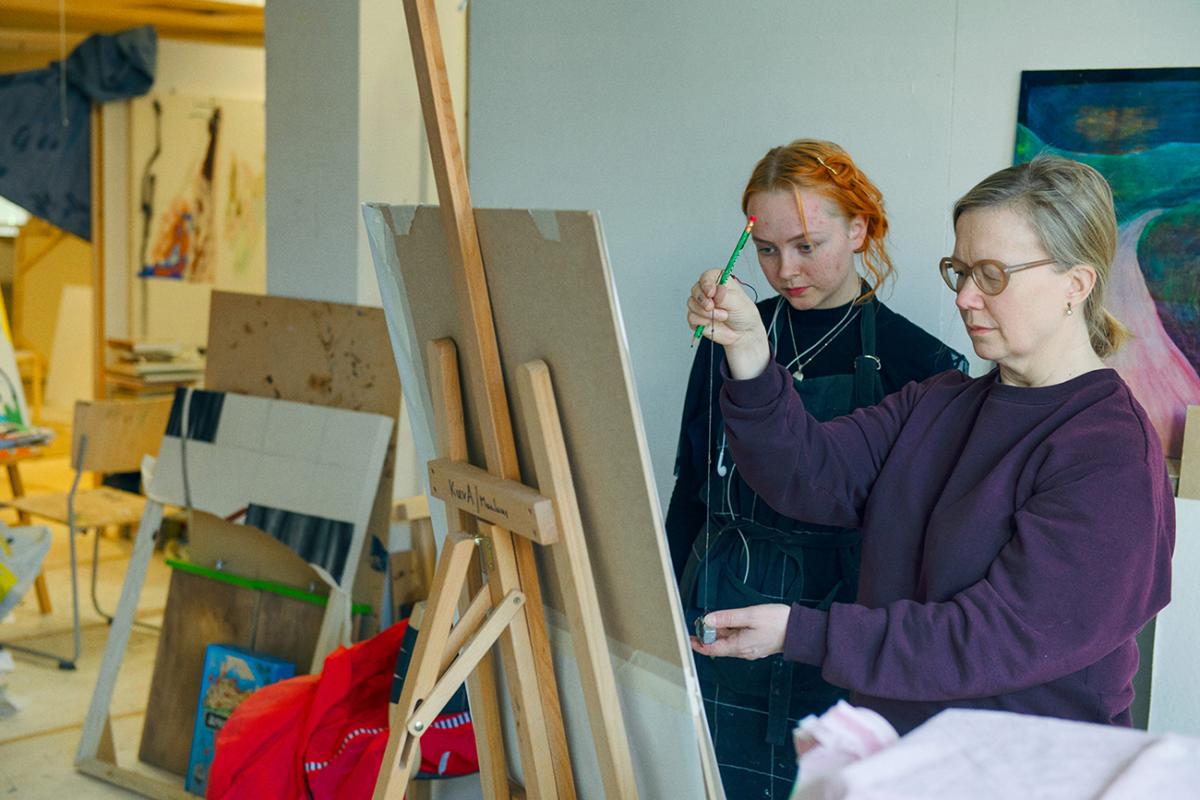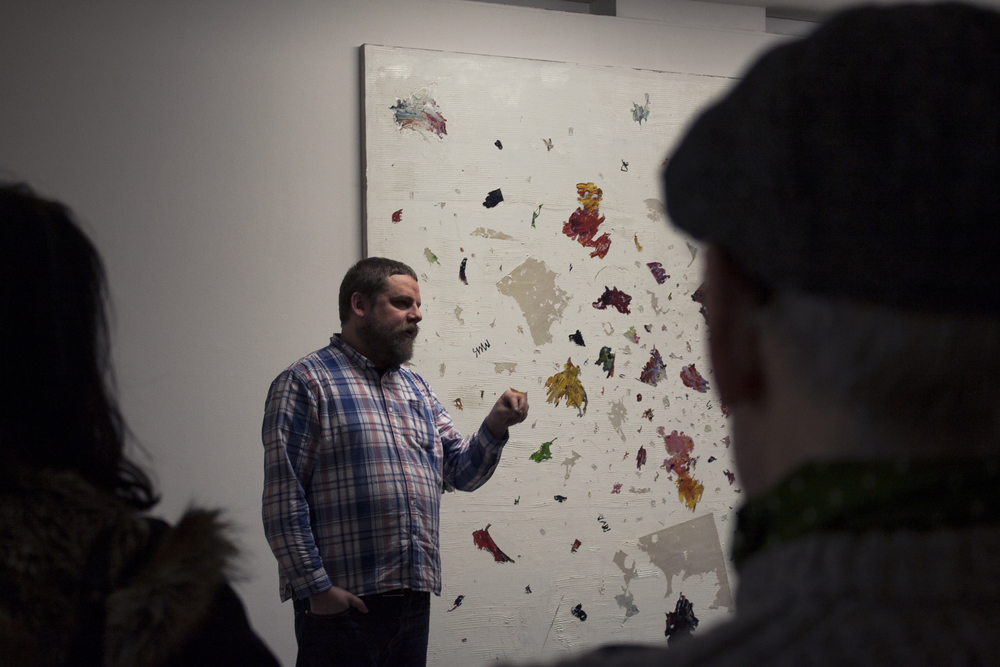Magnus Quaife: Uniarts Helsinki aims at becoming an international hub for fine art pedagogy
Magnus Quaife has been the Professor of Fine Art Pedagogy at the Academy of Fine Arts in Uniarts Helsinki since 2021. The research, methodology and teaching of artists’ pedagogies is still quite new and he is busy creating a network of researchers to develop the discipline further. The article is part of a series about the future of Uniarts Helsinki from a research standpoint.

For centuries, artists have taught other artists either in their own studios or in art schools. History books have been written about some well-established art schools and famous artists describing, among other things, their teaching methods. Some research has also been done on fine art pedagogy at the university level, but not very much. As a separate discipline, it is still fairly new.
About ten years ago, Magnus Quaife and some of his colleagues at the Manchester School of Art started developing a network around fine art pedagogy. He is a painter and has a PhD from the Manchester Institute for Research in Art and Design.
“We realised that there was a need for cooperation and networking of teachers of painting at the higher education level. There weren’t specific forums for this, only what has been described as a street level of knowledge between artist educators. Working with Ian Hartshorne and Donal Moloney, who were also working at Manchester School of Art, we created an organisation called Teaching Painting to organise symposia, curate exhibitions, and build an international network of artist teachers. Some incredible people got involved, and I think at its best it was genuinely inspiring, as well as being a vehicle for sharing our practices,” Quaife explains.
This is one of the aspects of his work that Uniarts Helsinki was interested in.
“At Uniarts Helsinki, our research focus is broader in that it includes teaching across the different art forms, but also very specific in that we are exploring artists’ pedagogies.”

Uniarts Helsinki invests in art pedagogy
In 2021, when Quaife was appointed as a professor of fine art pedagogy at Uniarts Helsinki, it was announced that Uniarts Helsinki had established university pedagogy in the arts as the new core of its research profile. The Academy of Finland has allocated a total of 750,000 euros to the new research profile area for 2021–2026, and Quaife’s professorship is funded by the Saastamoinen Foundation.
“In addition to this core funding, we are applying for further support to organise conferences and symposia focusing on different aspects of artist’s pedagogies at Uniarts Helsinki in the coming years. Building international networks of university pedagogues in general and fine art pedagogues in particular is important for developing our discipline,” Quaife says.
“Our ambition is for Uniarts Helsinki to become an international hub for art pedagogy studies and we are building an international community of researchers. We are, for example, organising a monthly on-line lecture series as well as the symposiums and conferences every year which will bring leading figures here.”
In November 2022, Uniarts Helsinki will host the prestigious Elia Biennial Conference on higher arts education. Elia is a European network of art schools and teachers representing 260 members in 48 countries across all art disciplines.
“In the EU, we have great opportunities to develop fine art pedagogy. There is, for example, the EU4Arts alliance between European art academies in Budapest, Dresden, Rome, and Riga that Uniarts Helsinki and HEAR Strasbourg/Mulhouse will be joining. It aims at creating cooperation between art schools including increased mobility and a pan-European Master of Fine Arts degree (MFA).”
Art pedagogy changes with the world
Art is taught very differently today compared to a hundred years ago.
“The world changes and art has a direct relationship to the world. Heidegger wrote that art destabilises and then reorganises our relationship to the world. Art is in dialogue with the conditions of its production, and our ideas of art itself develop over time. So art academies and their pedagogies have to evolve,” Quaife explains.
There have been some recent conversations about the Academy of Fine Arts’ educational methods.
“There have, for example, been important debates about decolonising the curriculum, which is an important and ongoing process. Other changes have, however, come in response to circumstances I don’t think anyone was prepared for. The pandemic forced art schools around the world to employ new approaches to teaching. As we begin to reflect on an intense period for the staff and students, it is clear that we have learned a great deal,” Quaife says.
One reason for the change in fine art pedagogy is that artists are constantly questioning the mechanics and structures of the art world.
“For example, times of political and economic turmoil are often reflected in the interests and practices of the students and this includes a more acute questioning of the art world itself. At the same time, climate change has necessitated a questioning of most aspects of our work. The art academy is not outside of these problems. Equally, there has been an increased understanding that there is still so much work to do around issues of equality and diversity. Since we can’t predict the future, we need education that is nimble and can adjust to different futures.”
Some differences between European art universities
Even between European countries, the methods and approaches to art pedagogy vary.
“There are so many art schools in Europe. The UK alone has more than a hundred places you can get an undergraduate degree in Fine Art. In the UK, we have a tradition of tutorial teaching, where the teachers and the students are in dialogue. Some other countries are more focused on the development of skill and still include more teaching via demonstration as part of their pedagogies,” Quaife compares different approaches.
Even the relationship to teachers vary.
”Students in the UK and Finland are amongst those that have many teachers and thus get a plurality of voices. In Germany, art students usually apply to study with one teacher and often stay with the same teacher for years. Germany is known for their art pedagogy research, but their focus tends to be at the pre-university level. Nevertheless, European art schools share many fundamental ideas even if their teaching is structured differently.”
Universities and other art schools in Europe are often state funded, but the ministries they are based in varies.
“Uniarts Helsinki answers to the Ministry of Education like many other art universities in Europe. On the other hand, certain institutions like the Royal Danish Academy and the École des Beaux-Arts in Paris fall under The Ministry of Culture. Consequently, their education is not standardised according to the Bologna Process and their curriculum structure can be different as a result.”
Redefining pedagogical approaches begins with research
“At Uniarts Helsinki, we are now doing research into artist pedagogies in higher education. I’m interested in how there can be some crossover from the other fields of teaching: how we can learn, borrow and adapt material from other pedagogical research both in Finland and internationally.”
Quaife has an interesting approach to pedagogy: he gathers oral accounts of learning and teaching at university level art schools.
“I’m interested in hearing experiences about what artists themselves think has worked well for them – and what has not worked at all. My methodologies borrow from phenomenology and post-structuralism. I am interested in how people experience education as students and teachers as well as the shared values and assumptions that drive pedagogy,” Quaife says.
“In teaching and research, you must understand your own values and allow these to be open to question. Henry Giroux is clear that education is never neutral, so art teachers as well as those of us researching their work must strive to understand what underpins our positions and viewpoints.”
At Uniarts Helsinki, there are some researchers and doctoral students writing about fine art pedagogy related subjects.
“With further funding, we can do increasingly ambitious research and build a community that will develop fine art pedagogy,” Quaife concludes.
Text: Päivi Brink